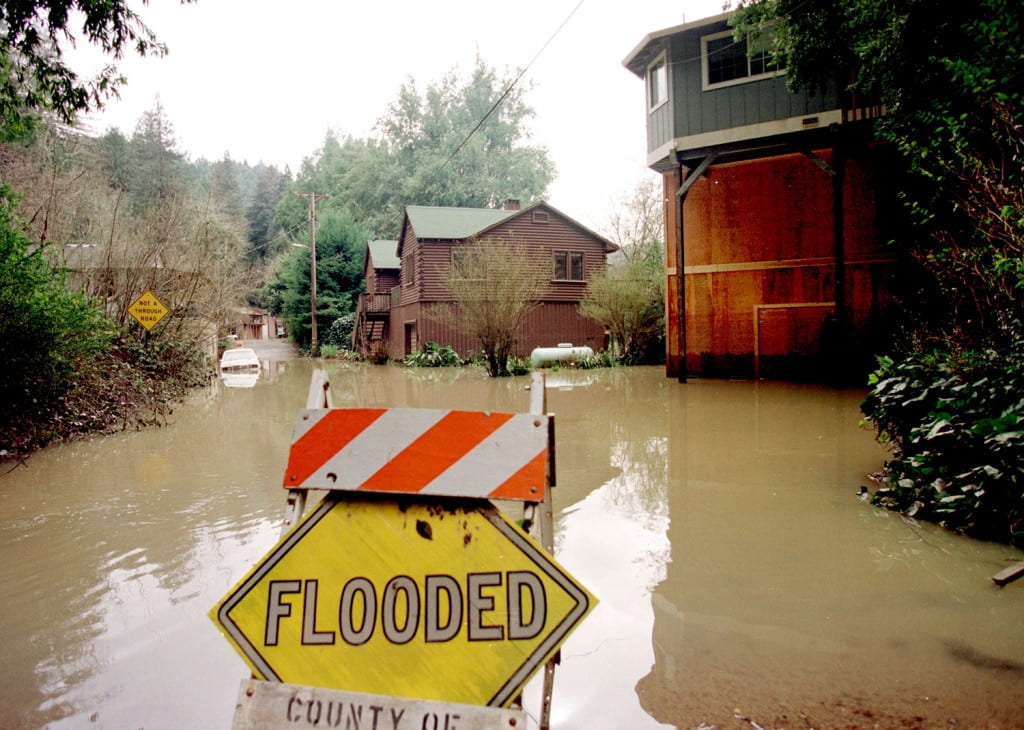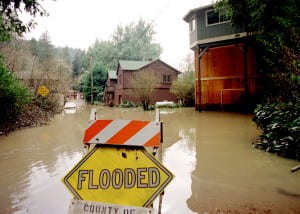Be careful what you wish for
Coming El Nino could gently replenish overstressed aquifers in parched state – or it might ravage vulnerable infrastructure

When respected climatologists describe this winter’s warming of tropical Pacific waters as a Godzilla El Nino event, they might be onto something. The science fiction monster’s signature move is to emerge from the ocean and destroy structures built by hapless humans. Many of the necessary plot elements are in place for El Nino to similarly wreak havoc in the Golden State in the coming months, says an expert in climate extremes at the University of California, Irvine.
“California is in year four of a severe drought,” says Amir AghaKouchak, assistant professor of civil & environmental engineering at UCI. “Earthen infrastructure around the state is dried out to the point of cracking. If a sudden overabundance of water from El Nino rains gets in those cracks, vital dams, levees and roadways can fail.”
An El Nino isn’t destructive in and of itself. It’s not a discrete weather event such as a hurricane or a tornado. It’s a climate phenomenon centering on above-average sea surface temperatures in the tropical Pacific Ocean – specifically, at least half a degree Celsius above normal for three or more months. The warming condition can lead to significantly higher rainfall in the southern United States, among other effects.

Dave Gatley / FEMA News Photo
Some El Ninos are incredibly powerful, while others come and go without much impact. Big events in 1982-83 and 1997-98 caused flooding, infrastructure damage and lots of headaches for Southern California commuters. The current El Nino has the potential to at least equal those.
In fact, average sea surface temperatures in the tropical Pacific for August, September and October of this year were 1.7 degrees Celsius above average, and the National Oceanic & Atmospheric Administration says there’s about a 95 percent chance that an El Nino will make its presence felt well into California’s winter rainy season.
That should come as welcome news to thirsty Californians, but there are risks. “Obviously, flooding is a big concern,” says AghaKouchak. “That can affect homes, roads, transportation and other infrastructure.”
He says the key question is whether California will get heavy deluges all at once or moderate precipitation spread out over the winter months. “If we get a good amount of rain over a long period of time, it would be much better for drought recovery and pose less danger to infrastructure,” AghaKouchak says. “If we get a lot of rain over a very short period of time, we won’t be able to store a lot of it, and we’ll have to let it go. And it could wreak havoc.”
There’s no mistaking the damage that can be done by a flash flood over parched terrain. A torrent of water from an intense thunderstorm in July washed out the supports holding up a bridge on Interstate 10 east of Palm Springs, Calif. The bridge collapse sent one motorist to the hospital, and a major artery connecting Arizona and Southern California was completely closed for over a week. It took more than two months and several million dollars for traffic to resume flowing in both directions.
While transportation infrastructure is obviously vulnerable, AghaKouchak is more worried about the many levees in place throughout California. In a letter published in the journal Science in August, he and other experts stressed that 55 percent of California’s levees are rated as “high hazard,” meaning there’s a risk of their failure in the event of a flood or an earthquake.
These earthen structures, made of soil, are affected by drought in a couple of ways. For one, the dirt itself has dried out and crumbled in places, and cracks have formed. Also, in the absence of rain or abundant surface water, farmers and other water users have tapped into groundwater supplies to an unprecedented extent.
“If we pump a lot of water out of the ground, we typically deal with land subsidence, which is another source of pressure on our earthen infrastructure,” AghaKouchak says.
But there may be some relief if California gets the hoped-for kind of rain: a little at a time over a long period. “You can have subsidence for a certain period of time, but then it can come back if there’s a lot of recharge back to the system,” AghaKouchak says. “But studies have shown that beyond a certain point, land may not behave elastically, and some permanent changes will happen. … The Earth does not respond like a sponge, unfortunately.”
He and fellow researchers at UCI are closely monitoring this season’s El Nino, not because they’re fans of disaster movies, but because of the opportunities it presents to learn about the relationship among ocean temperatures, rainfall, droughts and floods. “UC Irvine is well-poised to study climate extremes. We have faculty from engineering, social ecology, Earth system science and climate physics looking into different aspects,” AghaKouchak says.
“The research community here is very excited. First of all, it’s an extreme El Nino, and we haven’t had many of those in recent history,” he says. “And the pattern of this particular El Nino is different from previous ones. The ocean temperature at the higher latitudes is warmer than average, and we don’t really know how that’s going to impact rainfall, the jet stream or high-pressure ridges in the coming season. Everyone is on edge, waiting to see how this event is going to unfold.”